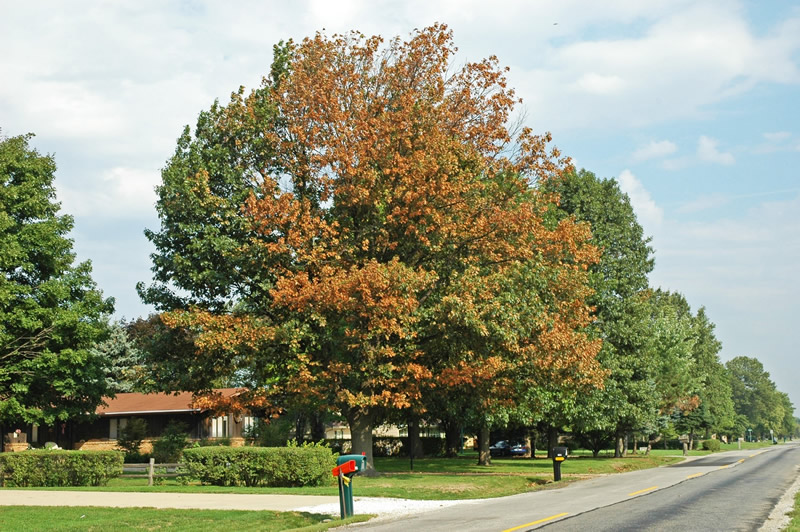Issue 9, August 12, 2019
Bacterial Leaf Scorch – New Molecular Service Available
It’s the time of the year that we start seeing bacterial leaf scorch symptoms develop in central Illinois, and several samples have been submitted that appear to be infected in the last few weeks. We are now offering a molecular test for this pathogen, which will reduce the turnaround time, and because it’s more sensitive than the previous ELISA test, ca be used any time during the growing season when symptoms appear.
Bacterial Leaf Scorch (BLS) is a serious infectious disease with a wide host range of trees and shrubs. The disease causes the slow decline of the host, resulting in host death. It is caused by the bacterium Xylella fastidiosa which is also responsible for Pierce’s Disease in grapes and is currently causing widespread damage to the Italian olive industry.
In Illinois, it affects a wide number of trees. The most common hosts in our state are oak (red oak group), elm, sycamore, London plane, sweetgum, hackberry, ginkgo, and maple (sugar and red). Many other woody and herbaceous plants can be susceptible to the pathogen. The bacteria is found only in the xylem (water-conducting) tissue of the plants, and is spread from host to host by root grafts. Xylem-feeding leafhoppers, treehoppers, and spittlebugs are also thought to act as vectors for the pathogen. The disease does not spread quickly between hosts.

Red oak leaves from a tree infected with BLS. Photo credit: Travis Cleveland / University of Illinois Plant Clinic
Scorch symptoms appear on leaves in early to midsummer, and gradually intensify as the season progresses. Affected leaves may turn a yellow/green color and then turn brown, usually from the margin of the leaf inwards (see picture). Older leaves are often affected first, and an individual branch or section of branches usually become discolored at the same time. Symptoms are generally not scattered throughout the crown. Branches will leaf out the following spring, but symptoms will re-appear and slowly spread through the crown of the tree over the course of subsequent seasons. Except in oaks, leaves generally do not drop until autumn.

Oak tree infected with BLS. Photo credit: Nancy Pataky / University of Illinois Plant Clinic
The symptoms are easily confused with drought stress, cultural problems, cankers, and, in oak trees, oak wilt. It can also be confused with Verticillium wilt in some trees. Submitting a sample to a plant diagnostic laboratory is the only way to definitively diagnose the disease. At the University of Illinois Plant Clinic, we use an antibody test to determine the presence or absence of the pathogen in symptomatic tissue. Testing is performed once a year, in late August or early September. This is because the population of bacteria within the affected tissue increases as the season progresses, so testing in late summer is most accurate due to the increased pathogen numbers. A test conducted in spring or early summer may result in a false negative due to the population of bacteria being too low.
If you suspect that a tree or shrub is affected by BLS, you may submit a sample to the University of Illinois Plant Clinic. Previously, we would store samples and test samples using an ELISA test in batches. With the new molecular test, we can run samples individually without having to batch them, resulting in reduced turnaround time for results. We used to wait until later in the season to test for BLS because the ELISA needed a high bacterial population for a strong positive. Because the molecular test is more sensitive than the ELISA, we can now test for this pathogen at any point during the growing season once symptoms appear.
Samples should consist of symptomatic leaves complete with the petiole (the structure that attaches the leaf to the branch). Ideally, at least a few of the leaves would be transitioning from green to brown. There is a $30 fee for this test. To download a sample submission form, please visit the Plant Clinic’s website at www.web.extension.illinois.edu/plantclinic and click on the “Sample Forms” tab. Please indicate that you wish the sample to be tested for BLS.
Management for trees affected with BLS consists of increasing tree vitality by mulching the base of the tree to retain moisture, watering during periods of dryness lasting more than two weeks, pruning out dead branches, and fertilizing when appropriate. While trunk injections with antibiotics have been shown to be effective at delaying symptom development, they do not cure the tree, and the injection sites open new paths of entry for organisms that decay wood. Over time, repeated treatments can severely weaken the tree. Choosing non-susceptible hosts to plant near affected trees is also recommended to prevent the spread of disease.
Authors:
Travis Cleveland
Diane Plewa